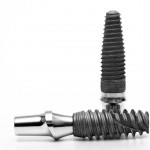
The immediate loading of implants with prosthesis is practiced commonly. This review sought to find out how immediate loading compared to conventional loading protocols depending on the type of prosthesis placed.
Methods
PubMed, Embase and CENTRAL were searched for randomised controlled trials of at least 6 months follow-up. They were eligible if they compared implants loaded within 1 week (immediate loading) to implants loaded after 2 months (delayed loading) and reported on implant failure. The authors intended to investigate the impact of:
- the extent of restoration (full-arch, partial, or single tooth prosthesis),
- type of restoration (provisional or definitive),
- material of the final restoration, and
- type of loading of the restoration (occlusal or non-occlusal)
Quality of included studies was assessed using the Cochrane Risk of Bias tool.
Results
- 29 studies were identified with follow up of between 6 and 84 months. The systematic review pooled data from 1,396 patients at baseline, 742 in the experimental group and 654 in the control, with a total of 2,739 implants placed (1,436 in the test and 1,303 in the control).
- 5 were at low, 8 at medium and 16 at high risk of bias.
- The overall effect of immediately loading resulted in a higher risk of implant failure when compared to the conventionally loading with a Relative Risk of 1.92 and 95% Confidence interval of 1.04-3.54. This means that there is almost twice the risk of implant failure when loaded immediately but the confidence interval is wide meaning that the risk of failure could be a little higher (if RR =1.04) or 3.5 times higher (if RR is 3.54).
- However, the absolute failure rates were very low in both groups: 1.8% in the immediate group and 0.4% in the conventional loading group. It’s unclear from this analysis when the implants failed.
- The subgroup analysis resulted in a higher risk of failure for immediately loaded implants with fixed prosthesis [RR = 1.98; 95% CI (1.02; 3.83); P = 0.042] and with metal-ceramic restorations [RR = 3.05; 95% CI (1.18; 7.88); P = 0.021].
Conclusions
The authors conclude
Immediate loading may impose a greater risk for implant failure when compared to conventional loading, although the survival rates were high for both groups.
Commentary
This review was well conducted but is at odds with a 2013 Cochrane review that concluded;-
Overall there was no convincing evidence of a clinically important difference in prosthesis failure, implant failure, or bone loss associated with different loading times of implants.
Links
Sanz-Sanchez I, Sanz-Martin I, Figuero E, Sanz M. Clinical efficacy of immediate implant loading protocols compared to conventional loading depending on the type of the restoration: a systematic review. Clinical oral implants research. 2014 Jun 11.
Esposito M, Grusovin MG, Maghaireh H, Worthington HV. Interventions for replacing missing teeth: different times for loading dental implants. Cochrane Database of Systematic Reviews 2013, Issue 3. Art. No.: CD003878. DOI: 10.1002/14651858.CD003878.pub5.

Immediate loading may increase dental implant failure compared to conventional loading http://t.co/3ozO03gftC via @sharethis
Dental implants: SR determines how immediate loading compared to conventional loading protocols. http://t.co/hQs5CGhPBK
Immediate loading of dental implants may impose a greater risk for implant failure than conventional loading. http://t.co/hQs5CGhPBK
Don’t miss: Immediate loading may increase dental implant failure compared to conventional loading http://t.co/hQs5CGhPBK
Cochrane SR finds no convincing evidence of a clinically important difference concerning loading times of implants http://t.co/hQs5CGhPBK
[…] Dental Elf – 3rd Sept 2014 – Immediate loading may increase dental implant failure compa… […]